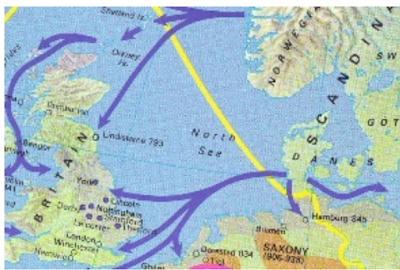I spend the morning putting the final touches to my so-called "presentation" that I've agreed to give to Lynda's local U3A Middle English group on zoom this afternoon.
Meanwhile Lois goes out for a walk on the local football field, and she takes the opportunity to spy on the latest horrible new building site, which for several weeks now has been hidden behind a hideous fence, destined to be later painted a horrible bright blue - yuck!
What a horrible mess - it's total madness !!!! And we feel desperately sorry for the people who live next to the site and have to look at it from their windows day after day. The builders have also sought to cut costs by only painting the fence on one side, which is good economics, but leaves rather an unsavoury and "sloppy" impression, that's for sure!
All in all, the whole thing leaves a nasty taste in her mouth, she says. So it's lucky we've got something nice for lunch - cheese and tomato on toast: yum yum!
14:30 Our U3A meeting starts, and I launch into my presentation. My topic is "How the Vikings Changed Our Language".
I have to say it is well received: the only problem is that so many questions and discussion points are raised as I work through what I have prepared, that the total run time is 100 minutes, and not the 40 minute estimate that I gave to Lynda, the group leader. My god !!!!
One of my slides shows how, with the arrival of the Vikings, their Old Norse language quickly began affecting, in particular, the dialects spoken in Yorkshire and also in Scotland.
According to Geipel “The Viking Legacy: The Scandinavian Influence on the English and Gaelic Languages” (1971),
....“to the great-great-grandparents of many of today’s Yorkshire folk, pigs were grice, heifers quees, and bullocks stots, yellow was gool, soft was blowt, large was stor and steep was brandt; bairns would laik where nowadays children play, and a man would risp if he had a lop on his rig where today he would scratch if he had a flea on his back”.
|
bairn |
ON barn ‘child’ |
|
crake |
ON kráka ‘crow’ |
|
erne |
ON örn ‘eagle’ |
|
fell |
ON fjall ‘mountain’ |
|
firth |
ON fjörðr ‘deep valley’ |
|
foss / force |
ON foss/fors ‘waterfall’ |
|
gate |
ON gata ‘street, road’ |
|
gill/ghyll |
ON gil ‘ravine’ |
|
gowk |
ON gaukr ‘cuckoo’ |
|
grice |
ON gris ‘pig’ |
|
lop |
ON fló ‘flea’ |
|
ness |
ON nes ‘headland’ |
|
nieve |
ON hnefi ‘fist’ |
|
rig |
ON hryggr ‘spine’, ‘ridge’ |
|
sca(u)r/skerry |
ON sker ‘barren rock in the sea’ |
|
tarn |
ON tjörn ‘lake’ |
|
thorp(e) |
ON þorp ‘village’ |
|
thwaite |
ON tveit ‘reclaimed part of land’ |
|
toft |
ON toft ‘homestead’ |
|
wuthering |
ON hviðr ‘breeze, gust’ |
|
blowt |
ON blautr ‘soft’ |
|
gool |
ON gulr ‘yellow’ |
|
sakless, sackless |
ON saklauss ‘innocent’ |
|
laik |
ON leika ‘play’ |
|
risp |
ON rispa ‘scratch’ |
|
thole |
ON þola ‘endure’ |
We've got three "Yorkshire folk" in our U3A group, and one Scotswoman, so I take the opportunity to ask how many of these words they understand or have used.
Surprisingly I find that they know most of these words, even if they haven't used them since their childhood.
What a crazy language we speak !!!!
16:15 The meeting ends and I feel totally drained. I'm getting old, no doubt about that! [You don't say! - Ed]
Tomorrow I'd better go out and buy myself a couple of new mugs - yikes!
Oh dear !!!!! A lot to learn before we visit Yorkshire again, that's for sure, let alone Scotland!
16:00 I have tea on the couch with Lois and I tell her about my "triumph" this afternoon, and she's pleased.
However, I have to admit that there were a few awkward questions asked, by the usual suspects in the group. One person asks me what the "yellow line" means on my Viking slide. This is some random slide I got off the internet because it showed the routes that the Vikings took when they arrived in the British Isles.
my "Viking" slide with the mysterious yellow line crossing the North Sea,















No comments:
Post a Comment